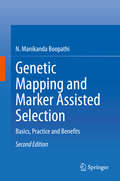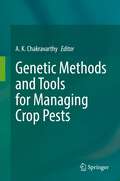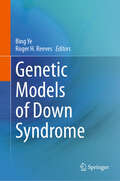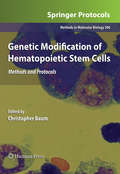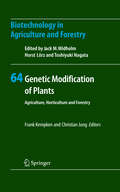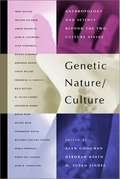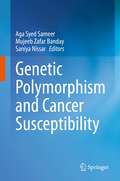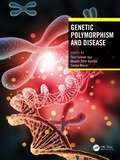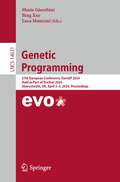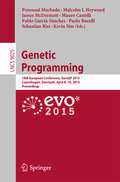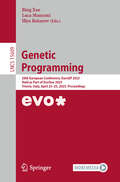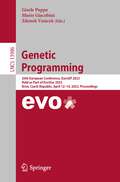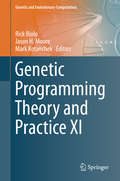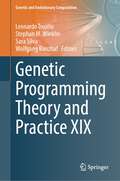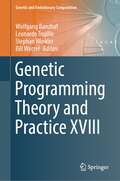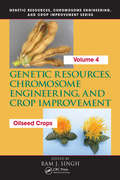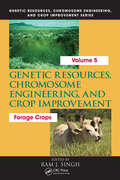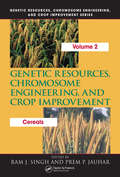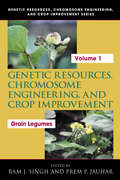- Table View
- List View
Genetic Mapping and Marker Assisted Selection: Basics, Practice and Benefits
by N. Manikanda BoopathiThe first edition of this book, Genetic Mapping and Marker Assisted Selection: Basics, Practice and Benefits, was widely appreciated as the first of its kind on this topic and has been listed as a reference work in several agricultural universities’ curricula. A great deal has happened over the last five years, making it high time to incorporate recent developments in genetic mapping and report on novel strategies in marker assisted selection in crop plants as a second edition. This book addresses a range of topics, including: new marker types and their genotyping methods based on high-throughput technologies, advances in genomics and their role in new marker development, improvements in genetic mapping strategies and software updates, developments in phenomics and their applications in QTL mapping, and how to incorporate these developments and advances in marker assisted selection in crop plants. Similar to the first edition, each technique and method is explained using a step-by-step method, allowing the book to serve as a self-study guide for scholars whose work involves the genetic improvement of crop plants for any trait of interest, particularly for biotic and abiotic stress resistance.In addition, the book offers a valuable guide for undergraduate and graduate students at agricultural universities and institutes that are interested and/or involved in the genetic improvement of crop plants using modern tools. In addition, the bibliography includes a list of suggested works for pursuing further research on the topics covered.
Genetic Mapping in Experimental Populations
by J.W. Van Ooijen J. JansenGenetic linkage maps are an increasingly important tool in both fundamental and applied research, enabling the study and deployment of genes that determine important biological traits. This concise introduction to genetic mapping in species with disomic inheritance enables life science graduate students and researchers to use mapping software to produce more reliable results. After a brief refresher on meiosis and genetic recombination, the steps in the map construction procedure are described, with explanations of the computations involved. The emphasis throughout is on the practical application of the methods described; detailed mathematical formulae are avoided and exercises are included to help readers consolidate their understanding. A chapter on recognising and solving problems provides valuable guidance for dealing with real-life situations. An extensive chapter dedicated to the more complex situation of outbreeding species offers a unique insight into the approach required for many economically important and model species, both plants and animals.
Genetic Methods and Tools for Managing Crop Pests
by A. K. ChakravarthyThis contributed volume aims at bringing together all the genetic engineering tools for managing various types of crop pests. The main focus of this book is to explore the application of these tools in pest management. Major pest groups covered in this book are insects, mites and nematodes.The first section covers all major genetic tools and molecular approaches. The second section deals with genetic tools for of beneficial containing three chapters involving honey bees, silkworms and natural enemies. Next section deals with genetic interactions against pests in diverse geographical regions with special focus on Africa, Vietnam and Sri Lanka. Sections four and five addresses diverse aspects as management of pests, genetic behavior, gene expression, plasticity, pathways and interactions and options for mitigation of pests.It serves as a useful resource for professionals in the fields of entomology, agronomy, horticulture, ecology, and environmental sciences, as well as to agricultural producers and plant biotechnologists.
Genetic Models of Down Syndrome
by Bing Ye Roger H. ReevesDown syndrome is a textbook example of a chromosomal disorder and is common, occurring in 1 in 700 live births in the US. While there are many books previously published on the genetics of Down syndrome, and many studies in diverse species, this is the first book of its kind on the research models for Down syndrome that covers animal models. This book offers an in-depth introduction and discussion of the genetic models of down syndrome across diverse species, including rodents, zebrafish, drosophila, and human organoids. Authors use a cross-cutting approach to compare the strengths and weaknesses of each model system, explore how to use model organisms to study human diseases, and capture the status of the field. This book is a useful resource for biomedical researchers and students interested in using model systems to study Down syndrome and learn about Down syndrome and other chromosomal disorders.
Genetic Modification of Hematopoietic Stem Cells
by Christopher BaumWith the incredible potential of gene transfer into hematopoietic stem cells, active research in this field has become critically important. In "Genetic Modification of Hematopoietic Stem Cells: Methods and Protocols", leading scientists in the field provide a compendium of protocols which cover the subject comprehensively, from the purification and culture of various types of hematopoietic cells for subsequent genetic modification by vector development and technical issues of small and large scale vector production, to the complex issue of monitoring and biosafety studies related to gene-modified hematopoiesis. Written in the highly successful Methods in Molecular BiologyTM series format, the chapters in this volume present brief introductions to the topic, lists of the necessary materials and reagents, step-by-step, readily reproducible laboratory protocols, and Notes sections, which allow the experts to highlight tips on troubleshooting and avoiding known pitfalls. Unique and cutting-edge, "Genetic Modification of Hematopoietic Stem Cells: Methods and Protocols" is an ideal, thorough resource to promote further research and the implementation of investigator-driven clinical studies using gene-modified hematopoietic cells.
Genetic Modification of Plants
by Christian Jung Frank KempkenConceived with the aim of sorting fact from fiction over genetically modified (GM) crops, this book brings together the knowledge of 30 specialists in the field of transgenic plants. It covers the generation and detection of these plants as well as the genetic traits conferred on transgenic plants. In addition, the book looks at a wide variety of crops, ornamental plants and tree species that are subject to genetic modifications, assessing the risks involved in genetic modification as well as the potential economic benefits of the technology in specific cases. The book's structure, with fully cross-referenced chapters, gives readers a quick access to specific topics, whether that is comprehensive data on particular species of ornamentals, or coverage of the socioeconomic implications of GM technology. With an increasing demand for bioenergy, and the necessary higher yields relying on wider genetic variation, this book supplies all the technical details required to move forward to a new era in agriculture.
Genetic Nature / Culture: Anthropology and Science Beyond the Two-Culture Divide
by Alan H. Goodman Deborah Heath M. Susan LindeeThis volume of original scholarship focuses on how anthropology is affected by and should respond to the wide range of issues associated with the culture and practice of genetics.
Genetic Polymorphism and cancer susceptibility
by Aga Syed Sameer Mujeeb Zafar Banday Saniya NissarThis book discusses the role of genetic polymorphism in susceptibility to cancers. The book explores the understanding of differences between the genetic polymorphisms and mutations.It reviews the mechanisms underlying the effect of polymorphism in genes encoding proteins that play an essential role in metabolism, signal transduction, cell cycle, and DNA repair mechanisms. Further, it investigates various techniques that are used for analyzing the genetic polymorphisms. The book contains many chapters which summarize the importance of genetic information obtained from polymorphism-based pharmaco-genetic tests to predict better drug response and life-threatening adverse reactions to chemotherapeutic agents, help in understanding of the impact of SNPs on gene function, and gives overview of the different SNP databases for examination. This book, therefore, serves as an essential guidebook for independent researchers as well as institutions working in this specialised field.
Genetic Polymorphism and Disease
by Syed Sameer Aga Mujeeb Zafar Banday Saniya NissarGenetic polymorphisms are important determinants of phenotypic variations and may modulate the risk to or even cause various diseases including genetic disorders and multifactorial diseases. Genetic polymorphisms also serve as important genetic, population and evolutionary markers that allow the study of genetic and evolutionary aspects of individuals, populations and organisms and aid in tracing the evolutionary and parental lineages. Genetic polymorphisms in low penetrance genes are responsible for the alterations in the gene expression of critical signal transduction proteins and metabolic enzymes. Some of these polymorphisms are linked to increased susceptibility to various diseases especially cancers, cardiovascular diseases, immune disorders, neurological pathologies. This book collates the reviews on the roles played by polymorphisms in critical metabolic, signal transduction, cell cycle or DNA repair genes either directly or indirectly in the disease mechanisms. The focus is on various techniques for identifying the various Single Nucleotide Polymorphisms (SNPs). Polymorphism studies document the affect SNPs, and their expressions have upon the functionality of the enzymes, proteins. Key Features Describes the genetic polymorphism and its various types Discusses the role of genetic polymorphisms in modulating the risk of various human diseases Explores various molecular techniques used for detecting GPs Characterizes the role of SNPs in modulating the susceptibility of human diseases Provides a genetic basis for individual variations in response to therapeutics
Genetic Polymorphisms and Susceptibility to Disease
by M. S. Miller M. T. CroninGenetic Polymorphisms and Susceptibity to Disease provides a reference for established researchers in genetic research. The book provides a broad but thorough overview of how allelic gene differences influence disease susceptibility in the human population, and will be a useful reference to researchers across a range of disciplines, for example, on
Genetic Programming: 27th European Conference, EuroGP 2024, Held as Part of EvoStar 2024, Aberystwyth, UK, April 3–5, 2024, Proceedings (Lecture Notes in Computer Science #14631)
by Mario Giacobini Bing Xue Luca ManzoniThis book constitutes the refereed proceedings of the 27th European Conference on Genetic Programming, EuroGP 2024, held in Aberystwyth, UK, April 3–5, 2024 and co-located with the EvoStar events, EvoCOP, EvoMUSART, and EvoApplications.The 13 papers (9 selected for long presentation and 4 for short presentation) collected in this book were carefully reviewed and selected from 24 submissions. The wide range of topics in this volume reflects the current state of research in the field. The collection of papers cover topics including developing new variants of GP algorithms, as well as exploring GP applications to the optimization of machine learning methods and the evolution of control policies.
Genetic Programming
by Penousal Machado Malcolm I. Heywood James Mcdermott Mauro Castelli Pablo García-Sánchez Paolo Burelli Sebastian Risi Kevin SimThis book constitutes the refereed proceedings of the 18th European Conference on Genetic Programming, EuroGP 2015, held in Copenhagen, Spain, in April 2015 co-located with the Evo 2015 events, EvoCOP, Evo MUSART and Evo Applications. The 12 revised full papers presented together with 6 poster papers were carefully reviewed and selected form 36 submissions. The wide range of topics in this volume reflects the current state of research in the field. Thus, we see topics as diverse as semantic methods, recursive programs, grammatical methods, coevolution, Cartesian GP, feature selection, initialisation procedures, ensemble methods and search objectives; and applications including text processing, cryptography, numerical modelling, software parallelisation, creation and optimisation of circuits, multi-class classification, scheduling and artificial intelligence.
Genetic Programming: 28th European Conference, EuroGP 2025, Held as Part of EvoStar 2025, Trieste, Italy, April 23–25, 2025, Proceedings (Lecture Notes in Computer Science #15609)
by Luca Manzoni Bing Xue Illya BakurovThis book constitutes the refereed proceedings of the 28th European Conference on Genetic Programming, EuroGP 2025, held in Trieste, Italy, during April 23–25, 2025 and co-located with the EvoStar events, EvoCOP, EvoMUSART, and EvoApplications. The 10 full papers were and 5 short papers included in this volume were carefully reviewed and selected from 27 submissions.The wide range of topics in this volume reflects the current state of research in the field. The universality of computer programs and their importance in so many areas of our lives means that automating these tasks is an exceptionally ambitious challengewith far-reaching implications.
Genetic Programming: 26th European Conference, EuroGP 2023, Held as Part of EvoStar 2023, Brno, Czech Republic, April 12–14, 2023, Proceedings (Lecture Notes in Computer Science #13986)
by Gisele Pappa Mario Giacobini Zdenek VasicekThis book constitutes the refereed proceedings of the 26th European Conference on Genetic Programming, EuroGP 2023, held as part of EvoStar 2023, in Brno, Czech Republic, during April 12–14, 2023, and co-located with the EvoStar events, EvoCOP, EvoMUSART, and EvoApplications. The 14 revised full papers and 8 short papers presented in this book were carefully reviewed and selected from 38 submissions. The wide range of topics in this volume reflects the current state of research in the field. The collection of papers cover topics including developing new variants of GP algorithms for both optimization and machine learning problems as well as exploring GP to address complex real-world problems.
Genetic Programming Theory and Practice XI
by Rick Riolo Jason H. Moore Mark KotanchekThese contributions, written by the foremost international researchers and practitioners of Genetic Programming (GP), explore the synergy between theoretical and empirical results on real-world problems, producing a comprehensive view of the state of the art in GP. Topics in this volume include: evolutionary constraints, relaxation of selection mechanisms, diversity preservation strategies, flexing fitness evaluation, evolution in dynamic environments, multi-objective and multi-modal selection, foundations of evolvability, evolvable and adaptive evolutionary operators, foundation of injecting expert knowledge in evolutionary search, analysis of problem difficulty and required GP algorithm complexity, foundations in running GP on the cloud - communication, cooperation, flexible implementation, and ensemble methods. Additional focal points for GP symbolic regression are: (1) The need to guarantee convergence to solutions in the function discovery mode; (2) Issues on model validation; (3) The need for model analysis workflows for insight generation based on generated GP solutions - model exploration, visualization, variable selection, dimensionality analysis; (4) Issues in combining different types of data. Readers will discover large-scale, real-world applications of GP to a variety of problem domains via in-depth presentations of the latest and most significant results.
Genetic Programming Theory and Practice XIX (Genetic and Evolutionary Computation)
by Leonardo Trujillo Stephan M. Winkler Sara Silva Wolfgang BanzhafThis book brings together some of the most impactful researchers in the field of Genetic Programming (GP), each one working on unique and interesting intersections of theoretical development and practical applications of this evolutionary-based machine learning paradigm. Topics of particular interest for this year´s book include powerful modeling techniques through GP-based symbolic regression, novel selection mechanisms that help guide the evolutionary process, modular approaches to GP, and applications in cybersecurity, biomedicine and program synthesis, as well as papers by practitioner of GP that focus on usability and real-world results. In summary, readers will get a glimpse of the current state of the art in GP research.
Genetic Programming Theory and Practice XVIII (Genetic and Evolutionary Computation)
by Leonardo Trujillo Wolfgang Banzhaf Bill Worzel Stephan WinklerThis book, written by the foremost international researchers and practitioners of genetic programming (GP), explores the synergy between theoretical and empirical results on real-world problems, producing a comprehensive view of the state of the art in GP. In this year’s edition, the topics covered include many of the most important issues and research questions in the field, such as opportune application domains for GP-based methods, game playing and co-evolutionary search, symbolic regression and efficient learning strategies, encodings and representations for GP, schema theorems, and new selection mechanisms. The book includes several chapters on best practices and lessons learned from hands-on experience. Readers will discover large-scale, real-world applications of GP to a variety of problem domains via in-depth presentations of the latest and most significant results.
Genetic Recombination
by Alan S. WaldmanGenetic recombination is any process in which DNA sequences interact and undergo a transfer of information, producing new "recombinant" sequences that contain information from each of the original molecules. This book presents leading peer-reviewed protocols to carry out recombinant investigations in the lab. Part I provides approaches and model systems for studying several aspects of recombination in a variety of eukaryotic organisms and in mammalian parasites. Part II describes approaches for using recombination as a reporter of genomic instability in lower and higher eukaryotes. Part III discusses various methods and approaches for targeted genomic manipulation in higher and lower eukaryotes, while the final part presents biochemical analyses useful for furthering the understanding of recombination mechanisms, thus making this an invaluable book for both the novice and the established researcher in the field of recombination.
Genetic Research on Addiction
by Audrey R. ChapmanThe manner in which genetic research associated with addiction is conducted, interpreted and translated into clinical practice and policy initiatives raises important social, ethical and legal issues. Genetic Research on Addiction fulfils two key aims; the first is to identify the ethical issues and requirements arising when carrying out genetically-based addiction research, and the second is to explore the ethical, legal and public policy implications of interpreting, translating and applying this research. The book describes research guidelines on human protection issues such as improving the informed consent process, protecting privacy, responsibilities to minors and determining whether to accept industry funding. The broader public health policy implications of the research are explored and guidelines offered for developing effective social interventions. Highly relevant for clinicians, researchers, academics and policy-makers in the fields of addiction, mental health and public policy.
Genetic Resources, Chromosome Engineering, and Crop Improvement: Oilseed Crops, Volume 4 (Genetic Resources Chromosome Engineering & Crop Improvement)
by Paul C. H. LiSummarizing landmark research, Volume 4 of this essential seriesfurnishes information on the availability of germplasm resources that breeders can exploit for producing high-yielding oilseed crop varieties. Written by leading international experts, this volume presents the most up-to-date information on employing genetic resources to increas
Genetic Resources, Chromosome Engineering, and Crop Improvement: Forage Crops, Vol 5
by Ram J. SinghIn recent decades, livestock producers have moved away from open grazing for a number of reasons, none having to do with the health of consumers. Genetic Resources, Chromosome Engineering, and Crop Improvement: Forage Crops demonstrates how state-of-the-art technology can encourage the raising of livestock in open pastures where they can be fed gra
Genetic Resources, Chromosome Engineering, and Crop Improvement: Vegetable Crops, Volume 3
by Ram J. SinghSummarizing landmark research, Volume 3 of this essential series furnishes information on the availability of germplasm resources that breeders can exploit for producing high-yielding vegetable crop varieties. Written by leading international experts, this volume offers the most comprehensive and up-to-date information on employing genetic resource
Genetic Resources, Chromosome Engineering, and Crop Improvement: Medicinal Plants, Volume 6
by Ram J. SinghMedicinal Plants, Volume 6 of the Genetic Resources, Chromosome Engineering, and Crop Improvement series summarizes landmark research and describes medicinal plants as nature's pharmacy. HighlightsExamines the use of molecular technology for maintaining authenticity and quality of plant-based productsDetails reports on individual medicinal plants i
Genetic Resources, Chromosome Engineering, and Crop Improvement: Cereals, Volume 2
by Ram J. Singh Prem P. JauharSummarizing landmark research, Volume 2 of this essential series furnishes information on the availability of germplasm resources that breeders can exploit for producing high-yielding cereal crop varieties. Written by leading international experts, this volume offers the most comprehensive and up-to-date information on employing genetic resources t
Genetic Resources, Chromosome Engineering, and Crop Improvement: Grain Legumes, Volume I
by Ram J. Singh Prem P. JauharThe first book in this new series discusses grain legumes, which rank only second to cereals in supplying calories and protein to the world's population. With each chapter written by an internationally renowned scientist, the book reviews the role of alien germplasm for the domestication of each major legume crop. Discussion for each crop covers or
